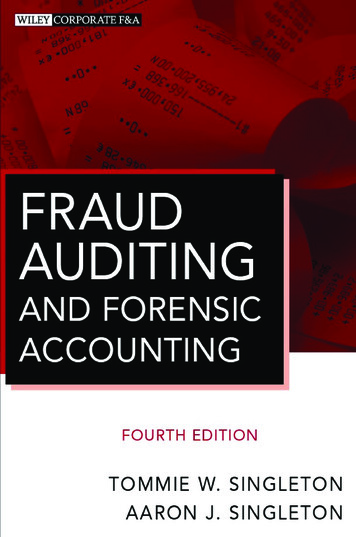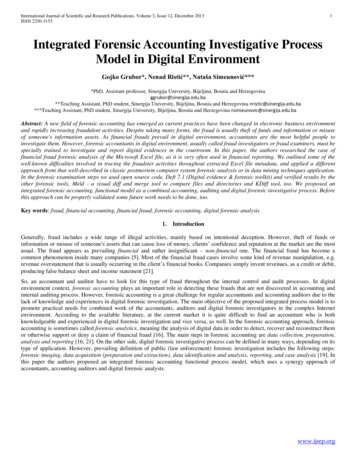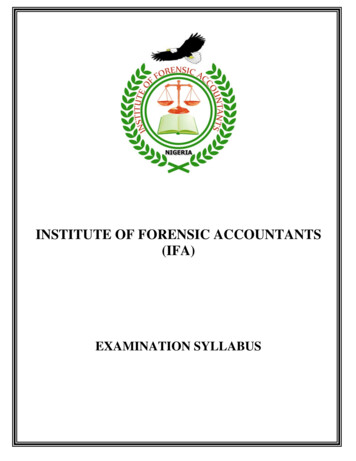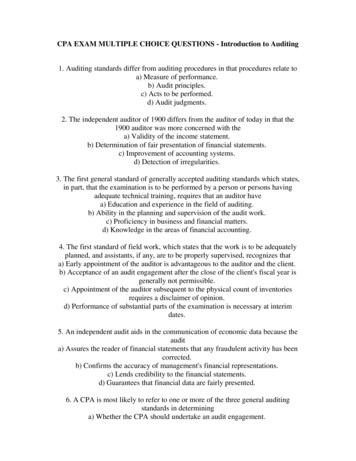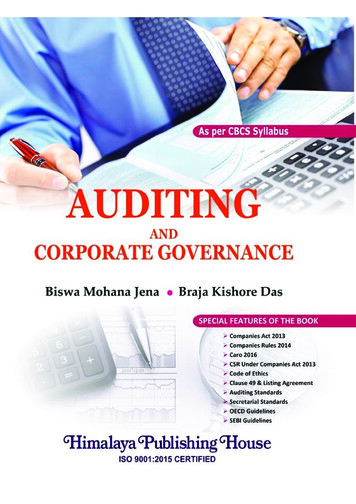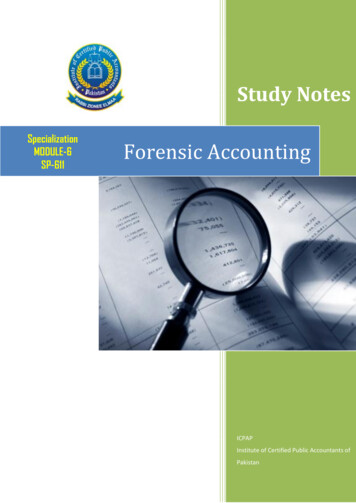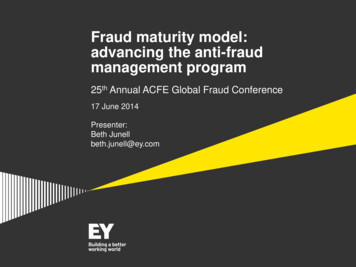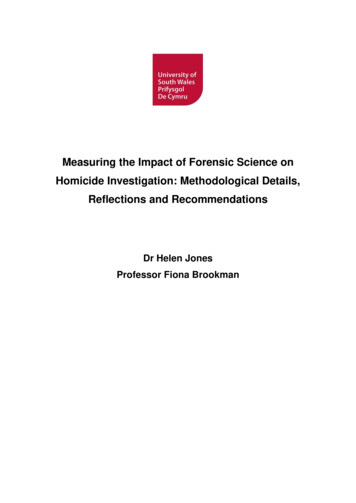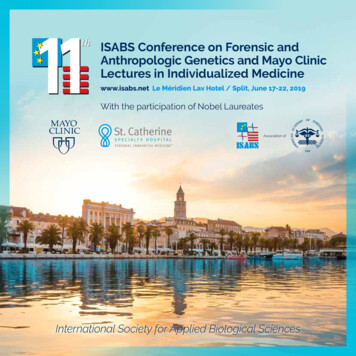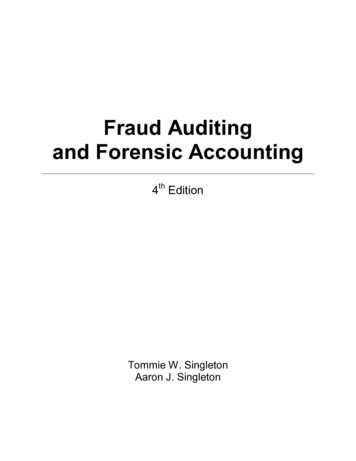
Transcription
Fraud Auditingand Forensic Accounting4th EditionTommie W. SingletonAaron J. Singleton
Table of ContentsPreface. viiChapter 1 – Background of Fraud Auditing and Forensic Accounting . 1Learning Objectives . 1Introduction . 1Brief History of Fraud and the Antifraud Profession. 2The Fraud Cycle . 4Review of Technical Literature. 5Forensic Accountant and Audits . 7Forensic Accountants . 12Fraud Auditors . 15Keys to Effective Fraud Investigation . 19The Antifraud Professional’s Career . 20Summary . 22Review Questions . 23Review Answers . 26Chapter 2 – Fraud Principles . 29Learning Objectives . 29Introduction . 29Definition: What Is Fraud? . 29Synonyms: Fraud, Theft, and Embezzlement . 31Classic Fraud Research. 31Fraud Triangle . 32Scope of Fraud . 34Profile of Fraudsters . 35Who Is Victimized By Fraud Most Often? . 38Fraud Taxonomies. 39Fraud Tree . 44Evolution of a Typical Fraud . 47Summary . 48Review Questions . 49Review Answers . 51Chapter 3 – Fraud Schemes . 53Learning Objectives . 53Introduction . 53ACFE Fraud Tree . 53Financial Statement Schemes . 58Corruption Schemes . 60Asset Misappropriation Schemes . 61Summary . 67Review Questions . 68Review Answers . 70Chapter 4 – Red Flags . 72Learning Objectives . 72Introduction . 72Professional Standards . 73Common Red Flags . 74Specific Red Flags . 76i
Fraud Detection Model . 82Summary . 82Review Questions . 83Review Answers . 84Chapter 5 – Fraud Risk Assessment . 85Learning Objectives . 85Introduction . 85Technical Literature and Risk Assessment . 85Risk Assessment Factors . 86Risk Assessment Best Practices . 89Risk Management Checklists and Documentation . 93Summary . 95Review Questions . 96Review Answers . 97Chapter 6 – Fraud Prevention . 98Learning Objectives . 98Introduction . 98Prevention Environment . 98Perception of Detection . 100Classic Approaches . 102Other Prevention Measures. 103Accounting Cycles . 104Summary . 105Review Questions . 107Review Answers . 108Chapter 7 – Fraud Detection . 109Learning Objectives . 109Introduction . 109Fraud Detection Axioms. 109Common Detection Methods . 109Specific Detection Methods . 111Summary . 115Appendix 7a: Beneish’s Ratios . 116Review Questions . 117Review Answers . 118Chapter 8 – Fraud Response . 119Learning Objectives . 119Introduction . 119Fraud Policy. 119Fraud Response Team . 121Recovery. 123Summary . 124Appendix 8A: ACFE Sample Fraud Policy . 125Appendix 8B: Sample Fraud Policy Decision Matrix . 127Review Questions . 128Review Answers . 129Chapter 9 – Computer Crime . 130Learning Objectives . 130ii
Introduction . 130History and Evolution of Computer Crimes . 130Computer Crime Theories and Categorizations . 133Characteristics of the Computer Environment . 135Information Security (InfoSec) . 136Profiling Internet Fraudsters . 137Summary . 141Review Questions . 143Review Answers . 144Chapter 10 – Fraud and the Accounting Information System . 146Learning Objectives . 146Introduction . 146Accounting Concepts . 146Segregation of Duties . 151Accounting Information Systems . 151Key Personnel . 152Computer Hardware . 154Computer Software . 155New Forms of Media. 156Audit Trail Concept. 156Summary . 157Review Questions . 158Review Answers . 159Chapter 11 – Gathering Evidence . 160Learning Objectives . 160Introduction . 160Rules of Evidence . 160Hearsay Exceptions . 162Other Rules of Evidence . 163Summary . 166Review Questions . 167Review Answers . 168Chapter 12 – Cyber Forensics . 169Learning Objectives . 169Introduction . 169Expectation of Privacy . 169Types of Investigations. 170Sources of Digital Data . 172Types of Cyber Data . 173Cyber Forensics Investigation Process . 174Variety of Specialists In Cyber Forensics . 176Summary . 177Review Questions . 178Review Answers . 179Chapter 13 – Obtaining and Evaluating Nonfinancial Evidence in a Fraud Investigation . 180Learning Objectives . 180Introduction . 180Interviews . 180Body Language . 182Deception Cues . 182iii
Eye Language . 183Statement Analysis . 184SCAN . 184Summary . 185Review Questions . 186Review Answers . 187Chapter 14 – General Criteria and Standards for Establishing an Expert Witness’s Qualifications. 188Learning Objectives . 188Introduction . 188Credentials . 188Personal Qualities of The Expert . 192Sources for Locating Expert Witnesses . 194Distinguishing the Actual Area of Competence . 195Summary . 196Review Questions . 197Review Answers . 198Chapter 15 – The Legal Role and Qualifications of an Expert Witness . 199Learning Objectives . 199Introduction . 199Role of a Forensic Accountant As a Witness In Court . 199Legal Qualifications for a Forensic Accountant as an Expert Witness . 203Qualification and Admissibility of Accounting Evidence . 204Expert’s Role in the Litigation Team . 205Pretestimony Activities . 205Summary . 206Appendix 15A: Transcript of Typical Court Testimony of Expert Witness. 207Review Questions . 209Review Answers . 210Chapter 16 – Effective Tactics and Procedures for the Expert Witness in Court . 211Learning Objectives . 211Introduction . 211Effective Profile . 211Being a Credible Expert Witness . 211Expert’s Role in the Litigation Team . 212Pretestimony Activities . 213Trial and Testimony . 213Survival Techniques . 218Summary . 219Review Questions . 220Review Answers . 221Chapter 17 – Fraud and the Public Accounting Profession. 222Learning Objectives . 222Introduction . 222History of Fraud and the Auditor: A Summary. 222Fraud and the Auditor’s Liability . 228Fraud and the Auditor’s Responsibility .
Fraud Auditing and Forensic Accounting 4th Edition Tommie W. Singleton Aaron J. Singleton . i Table of Contents . Microsoft Word - Fraud Auditing and Forensic Accounting Book.docx Author: Margie Created Date: 9/17/2012 4:59:18 PM .
